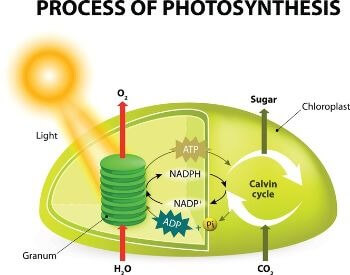
This web page contains photosynthesis facts for kids and is an excellent resource for anyone of any age looking to learn about the photosynthesis process. Our goal is to provide you with accurate, up to date facts about photosynthesis. In addition to facts about photosynthesis, we provide photosynthesis diagrams to help you better understand the process.
The photosynthesis facts below will help you learn how plants use photosynthesis to create energy, what other organisms use photosynthesis, how the photosynthesis process works and other facts about photosynthesis. We hope these photosynthesis facts are interesting and help you learn more about this chemical energy process.
If any of the below photosynthesis facts are inaccurate, please contact us and let us know.
21 Photosynthesis Facts for Kids
- Photosynthesis is a process that converts sunlight into a chemical energy.
- An organism that uses the photosynthesis process is called a photoautotroph.
- The first organisms on our planet to use photosynthesis appeared roughly 3.4 billion years ago.
- The photosynthesis process creates the oxygen that fuels life on Earth.
- The simple formula for photosynthesis is carbon dioxide + water + sunlight = sugar + oxygen.
- The complex formula for photosynthesis is 6CO2 + 6H2O + radiant energy → C6H12O6 + 6O2.
- Plants use the photosynthesis process to convert carbon dioxide, water and nutrients into a chemical energy.
- A plant absorbs carbon dioxide through stomates, which are tiny holes in leaves and stems.
- A plant absorbs wavelengths from the sun (radiant energy) through chlorophyll molecules.
- A plant absorbs water from its roots, leaves and stems.
- The molecules in carbon dioxide and water are broken down by radiant energy from the sun.
- The chemical energy created is stored in sugars (carbohydrates) inside of the roots and used as needed.
- Oxygen, which is the waste byproduct of photosynthesis, is released into the atmosphere via stomates.
- Photosynthesis is main source of oxygen in the Earth’s Atmosphere.
- Without photosynthesis, oxygen levels would plummet over time and almost all organisms would die. Only anaerobic organisms would survive, which are organisms that don’t require oxygen to grow.
- Bacteria known as cyanobacteria also use photosynthesis to create energy.
- Cyanobacteria are believed to have caused the Great Oxidation Event about 2.4 billion years ago.
- The Great Oxidation Event, also known as the Oxygen Catastrophe, started to increase oxygen levels in our atmosphere. This caused the extinction of many organisms as oxygen was poisonous to them. However, it allowed oxygen based multicellular organisms to explode and evolve.
- Plants play an important role on our planet. The photosynthesis process creates oxygen and reduces carbon dioxide in our atmosphere. Human activities, like the burning of fossil fuels and deforestation have negative effects on Earth.
- Fossil fuels add carbon dioxide directly to our atmosphere. This increases the temperature of the planet and has a global effect on weather patterns. Large forests and the rainforests play a big role in the oxygen cycle on our planet. However, humans continue to reduce the size of our forests for their own use.
- Think about it, humans continue to are add more carbon dioxide to the Earth’s atmosphere by burning of fossil fuels and at the same time we are reducing the size of Earth’s forests that convert carbon dioxide into oxygen via the photosynthesis process.
Diagrams of the Photosynthesis Process



Find More Facts About Photosynthesis
- What Is Photosynthesis – Learn about the photosynthesis process on the Smithsoian Science Education Center website.
- Photosynthesis Video for Kids – An excellent video created to teach kids about photosynthesis.
- Photosynthesis Expirement – A fun experiment you can do in the classroom or at home to learn about photosynthesis.
- Photosynthesis – Britannica – Discover more facts about photosynthesis on the Britannica website.
